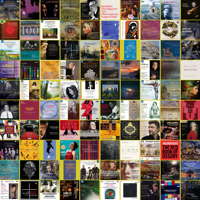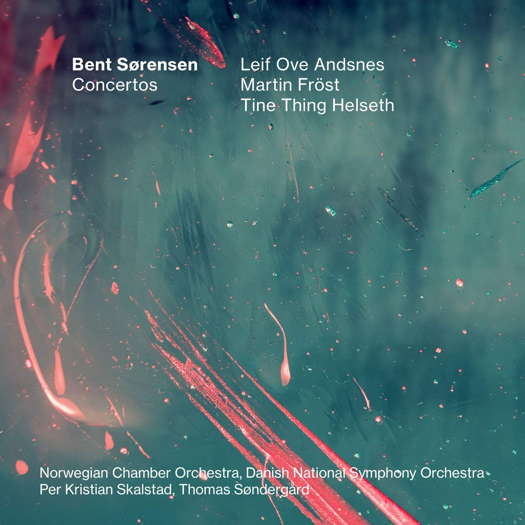- Tanglewood
- Hugo Wolf
- Florence Beatrice Price
- Music and Media Consulting Ltd
- al fresco
- Ockeghem
- Nicholas Hersh
- Place des Arts
 VIDEO PODCAST: Come and meet Eric Fraad of Heresy Records, Kenneth Woods, musical director of Colorado MahlerFest and the English Symphony Orchestra and others.
VIDEO PODCAST: Come and meet Eric Fraad of Heresy Records, Kenneth Woods, musical director of Colorado MahlerFest and the English Symphony Orchestra and others.
 UPDATES: There's a new feature every day at Classical Music Daily. Read about the various ways we can keep in touch with you about what's happening here.
UPDATES: There's a new feature every day at Classical Music Daily. Read about the various ways we can keep in touch with you about what's happening here.

Unique and Most Compelling
Concertos by Danish composer Bent Sørensen,
heard by EUGENE TAKEUCHI-WILLIAMS
'... in these three pieces, Sørensen is the consistent champion of the understatement.'
It has now long been acceptable for repetitiousness in art music to be met with scepticism. The fundamentally American school of 'Minimalism' per-se has seemingly exhausted its musical possibilities. Rhythm as timbre; melodies and rhythm as one and the same; the use of unisons to create ambiguities between instruments; the use of overlapping simplistic elements to form atmospheres; the acousmatic effects that arise from prolonged periods of repetition; and any combination of the above listed (give or take some others).
Sceptics of the 'school' - depending on whether you take the idea of 'schools' seriously: Steve Reich doesn't - likely suffer from a kind of confirmation bias. If Einaudi is the regrettable popular face of 'classical' music, surely Minimalism is spent, or at the very least, woefully out of touch.
It's true that for many of us Einaudi cheapens the music of his peers by association. But we ought not to be too hasty in putting a torch to repetition in general, as a musical device in the 21st century. Simplicity isn't and never was the same as Minimalism. I am a little less cynical than Reich about musical 'schools' as a non-composer myself: composers of 'New Simplicity' and the Danish 'Den Ny Enkelhed' - a separate movement spearheaded by Abrahamsen - often sound 'simple' without ever sounding like American Minimalists. And John Adams, 'post-minimalist' though he may be, was never actually 'simple'.
So, where does one place Bent Sørensen's repetitions, a regular feature of the pieces here concerned? It's clear that, if an organic feature of his style, it's a feature intent on staying. All three pieces on this album are concerti written pre-2010. In 2018, Sørensen won the Grawemeyer Award for L'Isola Della Citta (2016), a triple concerto which features those very same percussive repetitions, along with the signature glissandi and truncated melodies. In fact, it is a repeated G minor chord spread between the soloists that ends the piece, making it reminiscent of Britten's Second Quartet in that respect. (This is not an obvious comparison - Sørensen's ending is sombre and desolate - a long way from Britten's insistent finish.)
Sørensen's repetitions have never been the focal point of his pieces. This is what separates him from the more serious Minimalists, for whom all musical ideas must be filtered through those repetitions (whether the repetitions are themselves 'the point'). When you hear the repetitions, I find it feels like time has frozen in that brief moment - the ending to L'Isola ... - or that a rhythm played in one section of the orchestra is being mockingly echoed by another - strings and winds, Trumpet Concerto Mvt I, 2:25.
Listen — Bent Sørensen: I (Trumpet Concerto)
(track 9, 2:18-2:59) © 2020 Dacapo Records :
It is especially interesting when the line is blurred between boisterous steady pulses - Trumpet Concerto, Mvt III - and those more tentative 'echoes' into which they sometimes recede.
Listen — Bent Sørensen: III (Trumpet Concerto)
(track 11, 1:00-1:30) © 2020 Dacapo Records :
(Note 2:30 in La Mattina, Mvt V, where the orchestral repetitions lull the soloist into action.)
Listen — Bent Sørensen: Presto (La Mattina)
(track 5, 2:29-2:42) © 2020 Dacapo Records :
According to the composer, his music is centrally concerned with melody. His exploration of melodic lines is undoubtedly strongest in the Trumpet Concerto, done great justice by Tine Thing Helseth's dynamic performance. Perhaps this is unsurprising, given that it most directly resembles the traditional three movement concerto; here, Sørensen is freer to explore those compositional techniques. For example, what I called his 'truncated' melodies never feel like gimmicks in this piece, whereas they risk sounding tacked-on at the ends of movements in La mattina - the piano concerto which opens the album.
To be sure, the opening trumpet melody is developed throughout the first movement in a somewhat traditional way. But what is most impressive is the expressive power granted the soloist in more ambiguous moments in the piece. These moments are never devoid of melody, which is what gives Sørensen's music its unique and most compelling aspect. Somewhere between déjà vu and jamais vu, his melodies are always sinking into a larger melodic line, which here reaches its emotional peak in the dark middle movement.
In La Mattina, Sørensen boasts a great command over musical 'mood'. The beautiful opening textures are intriguing, and the presto movement is full of charm and energy, at one point almost threatening to burst into the opening of the Grieg Concerto.
Listen — Bent Sørensen: Presto (La Mattina)
(track 5, 1:12-1:49) © 2020 Dacapo Records :
I applaud pianist Leif Ove Andsnes for resisting the temptation; he would still have contributed to a great recording nonetheless, as he finds just the right balance with the orchestra throughout.
Similarly convincing are the atmospheres which pervade the clarinet concerto, Serenidad. Perhaps it's obvious of me to point to the last minute and a half of the piece as another highlight. It's a gorgeous display of 'less is more': overlapping clarinet lines recall the soloist's motif from the middle movement, and eventually everything falls into place; the final chord dies out - quick and unassuming - as if it were just stumbled upon by chance.
Listen — Bent Sørensen: III (Serenidad)
(track 8, 6:38-7:38) © 2020 Dacapo Records :
But this couldn't be further from the truth; in these three pieces, Sørensen is the consistent champion of the understatement.
Copyright © 28 April 2020
Eugene Takeuchi-Williams,
Durham, UK

CD INFORMATION - BENT SØRENSEN: CONCERTOS
FURTHER INFORMATION - BENT SØRENSEN
FURTHER INFORMATION - DACAPO RECORDS


